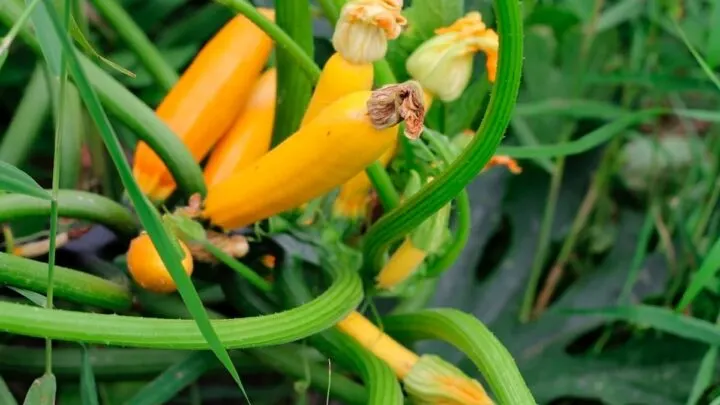Some plants can tolerate transplanting without issue, and others can be pretty dramatic about being quite literally uprooted and moved to a new area. If you originally planted your squash in a less than stellar location, you may need to move it to get a good harvest and make it a worthwhile crop to grow. Can you move squash plants?
You can move squash plants, but it should be avoided after they are at a mature stage. Squash plants do not like to be transplanted, and disturbing the root system can cause the plant to have issues.
It is better to do your research before transplanting seedlings outside, so relocation is not needed, but this isn’t always possible.
Keep reading to learn more about how to successfully transplant your squash plants and other information to ensure ample squash collection.

How do I successfully transplant squash?
Transplanting seedlings that were started indoors to an outdoor space should not cause any problems in the overall growth process, so long as the seedlings are hardened off appropriately to give them a good start in their life outdoors.
The problem may come when you move a more established, larger plant to a different area. This can be due to environmental inadequacies, such as too much shade, or if a nearby area has been contaminated with a virus or fungus and you no longer feel it is in your plant’s best interest to be in that vicinity.
Transplanting a squash plant that has been established can be challenging, especially in the middle of the growing season. It should be avoided unless necessary. Some things can be done to help ease the transition.
Firstly, take care to use a large enough tool so you can remove a large portion of the root system to minimize damage. A large hand tool or shovel can be used, depending on the size of the plant. Amend the soil in the new space with a small amount of compost. Take care to dig a hole deep and wide enough, so your plant’s roots have room to expand and settle. If you can, trim back your plant before moving and try to move it in the late evening so it has some time to recover. Water well once you have planted it in its new spot.
Keep in mind that there is a possibility the plant won’t make it. You may also see a lot of dieback due to root damage, which is unfortunately inevitable when moving a more established plant.

Give your plant a few weeks to get its footing again. If, after this time, the plant has declined more than 50% and looks to be on a continued downward trend, it may be time to start with a fresh plant in the right spot.
Care for your recently transplanted squash plant like any other freshly-planted crop. You may find shading it for the first week or so during the hottest parts of the day can help it adjust without risking sunburn.
When should I transplant squash?
Ideally, squash plants (summer and winter squashes) should be transplanted as established seedlings into the garden after all danger of frost has passed.
Choose a location that gets direct sun for at least 6 hours a day; any direction of light other than north-facing light should provide your plants with at least 6 hours of direct light. The soil should be well-draining. You can amend the soil with compost to help with drainage and nutrition since fertilizing a newly transplanted plant is not often recommended.
If you must transplant an established plant, you will want to do so when the temperatures are mild, and sun exposure is minimal; usually, this is in the evening or on a cloudy day. This will give your plant the best chance of survival since it won’t immediately be thrust into photosynthesizing and dealing with harsh summer temperatures.

Avoid transplanting during the middle of the day. This will almost certainly kill your plant since the shock and stress of uprooting it can already be too much for it to handle. Even transplanting in the early morning hours may not give your plant enough time to start the process of healing damaged roots.
Ultimately, doing a bit of research before planting any crop pays off, so you don’t have to go through the hassle of planting and moving it twice. It also benefits your plant and will likely lead to a more happy, productive crop when it only has to establish itself once.
Can you move squash vines?
Squash vines can get wild and jumbled very easily, leading to a tangled mess that can hinder some of your plant’s development. Moving squash vines may seem like a mess that isn’t worth it to get into, but once the squash begins developing, you’ll be glad you handled it.
Gently detangle the vines, pruning any leggy or unproductive growth if necessary. Avoid tugging or pulling on the vines since this can cause some accidental root damage if you wind up pulling the vines out of the ground.
Thinning out your plant can help with airflow to the stems and around the soil, preventing diseases and fungi from appearing in your garden. This will also make future pruning and harvesting plants more manageable, as you will be able to see squash that may be low-growing and therefore more susceptible to rot or being a snack for some insects.
Moving, pruning, or untangling squash vines is perfectly fine and even advisable, so the sooner you tackle the unraveling of the vines, the less of a mess you will have coming later in the growing season.

Final Thoughts
If your options are to let your established plant slowly wither away in a poor location or to move it in the middle of the growing season, it is worth a shot to move it into an area where it can thrive. Though, try to manage your expectations, as squash plants generally do not like to be moved once they’ve set their roots in an area.
Having some forethought in placement and management of the plant will do wonders for the ease of care of the crop throughout the season, and helps to keep your plant healthy, too.

Hi there, my name is Allie and welcome to my blog; GareningWithAllie!
Much of what you see written here is just our personal experiences with gardening. Along with the content I write here, there is also a unique collection of gardening topics covered by some of our close friends. I hope you find everything you read here to be helpful, informative, and something that can make your gardening journey the most lovely experience ever! With that said, Happy Gardening!
